Admiral Sir Ernest Frederick Augustus Gaunt, was an Australian-born Royal Navy officer who went on to be Commander-in-Chief, Western Approaches.

HMS Fox was a second class protected cruiser of the Astraea class of the Royal Navy. The class represented an improvement on previous types, 1,000 tons displacement larger with better seaworthiness due to improved hull design. It also had somewhat increased firepower and superior arrangement of guns.

HMS Mildura was a Pearl-class cruiser built for the Royal Navy in the late 1880s. Originally named HMS Pelorus, she was renamed after an Australian town in April 1890. Per the Imperial Defense Act of 1887, she served primarily in Australian waters.

HMS Royal Arthur was a first class cruiser of the Edgar class, previously named Centaur, but renamed in 1890 prior to launching. She served on the Australia Station and briefly on the North America and West Indies Station before returning to the Home Fleet in 1906. She was paid off after the First World War.

HMS Orlando was the lead ship of the Orlando class of first-class cruisers built in the yards of Palmers Shipbuilding and Iron Company, Jarrow and launched on 3 August 1886.

HMS Challenger was a second-class protected cruiser of the Challenger-class of the Royal Navy.
Admiral Sir George Lambart Atkinson-Willes was a Royal Navy officer who went on to be Commander-in-Chief, East Indies Station.
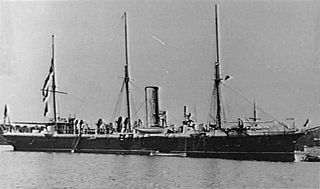
HMS Porpoise was an Archer-class torpedo cruiser of the Royal Navy, built by J. & G. Thompson at Glasgow and launched on 7 May 1886.
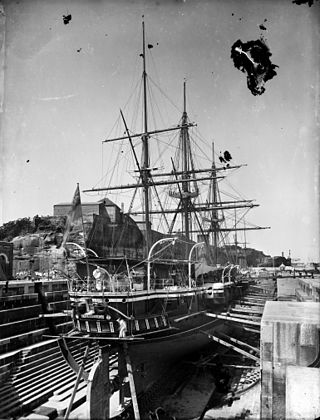
HMS Curacoa was a Comus-class corvette of the Royal Navy, built by John Elder & Co., Govan, launched in 1878, and sold in 1904 to be broken up. She served on the Cape of Good Hope and West Africa Station, the Australia Station and as a training cruiser in the Atlantic.

HMS Raven was a Banterer-class gunboat of the Royal Navy, built by Samuda Brothers of Poplar, London, and launched on 18 May 1882. She served on the Australia Station and was converted to a diving tender in 1904. After being lent as a training ship in 1913 she was sold for breaking in 1925.
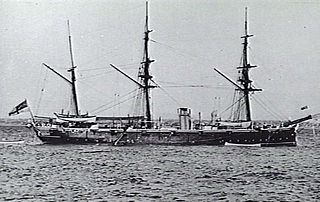
HMS Pylades was a Satellite-class composite screw sloop of the Royal Navy, built at Sheerness Dockyard and launched on 5 November 1884. She was later reclassified as a corvette and was the last corvette built for the Royal Navy until the Second World War.

HMS Rapid was a Satellite-class composite screw sloop of the Royal Navy, built at Devonport Dockyard and launched on 21 March 1883. She was later reclassified as a corvette.

HMS Boomerang was an Sharpshooter-class torpedo gunboat of the Royal Navy, originally named HMS Whiting, built by Armstrong Whitworth, Elswick, Tyne and Wear and launched on 24 July 1889. Renamed Boomerang on 2 April 1890, she formed part of the Auxiliary Squadron of the Australia Station.

HMS Dart was a schooner of the Royal Navy, built by the Barrow Shipbuilding Company, Barrow and launched in 1877 as Cruiser for Lord Eglinton. She was subsequently purchased by the Colonial Office for the use of Sir Arthur Hamilton Gordon as governor of the Fiji Islands. On his appointment to New Zealand, Cruiser was purchased by the Royal Navy as a tender for the training ship Britannia and the name changed to Dart in March 1882.
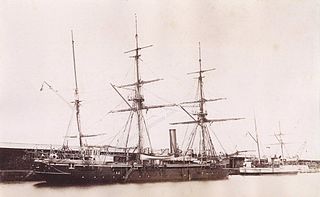
HMS Rambler was an Algerine-class gunvessel of the Royal Navy, built by John Elder & Co., Glasgow and launched on 26 January 1880. She was commissioned as a survey vessel in 1884 and served in Chinese waters during the 1880s and 1890s. She provided men to a naval brigade during the Boer War and was sold on 23 January 1907. The work of this vessel is now remembered in Hong Kong by the Rambler Channel near Tsing Yi.
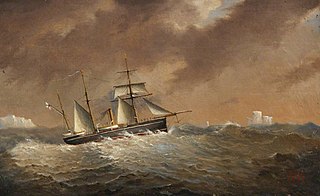
HMS Goldfinch was a Redbreast-class gunboat of the Royal Navy, built at Sheerness Dockyard and launched on 18 May 1889.

HMS Cambrian was a second-class protected cruiser, of the Royal Navy, built at the Pembroke Dockyard and launched on 30 January 1893. She was the last flagship of the Australia Station.

HMS Ringdove was a Redbreast-class gunboat of the Royal Navy, built at Devonport Dockyard and launched on 30 April 1889.

HMS Lizard was a Bramble-class screw gunboat of the Royal Navy, built by Harland & Wolff, Belfast and launched on 27 November 1886.

HMS Phoebe was a Pearl-class cruiser of the Royal Navy, in service from the early 1890s until 1906.



















